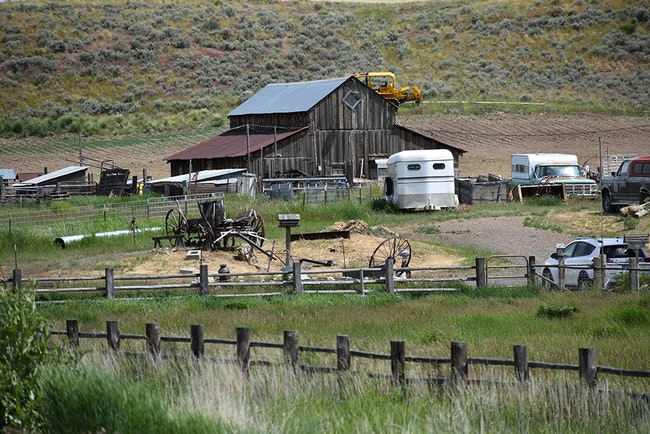 State Sen. Lynn Findley of Vale is sponsoring a land use bill to open up non-productive farm ground into the county to development.
State Sen. Lynn Findley of Vale is sponsoring a land use bill to open up non-productive farm ground into the county to development.
ONTARIO – A proposal to allow more housing in rural areas has new life at the Oregon Legislature.
Senate Bill 16, sponsored by state Sen. Lynn Findley, R-Vale, is designed to open inferior agriculture land to homes in the border region between Oregon and Idaho, including Malheur County. A similar proposal didn’t make it through the 2019 Legislature.
The bill is a key piece of the legislative strategy of the Eastern Oregon Border Economic Development Board, a seven-member committee of local people. The idea was the subject of a Feb. 9 hearing before the Senate Committee on Energy and Environment, which Findley vice chairs.
The legislation would “allow counties to partition and rezone up to 200 acres of lands within the Eastern Oregon Border Economic Development Region from exclusive farm use to residential uses.”
Findley feels good about the prospects for Senate Bill 16.
He noted that the version in the 2019 session – House Bill 2456 – made it out of the House with strong bipartisan support.
“I am very comfortable if the Senate has the opportunity they will support it,” said Findley.
Tiffany Cruickshank, chair of the Eastern Oregon Border Economic Development Board, said the legislation isn’t aimed at prime farm ground.
“We have a lot of land that is not being used that is not high value farmland and it is unsuited for cultivation. It is not irrigated or unique,” said Cruickshank.
The bill, she said, safeguards the area’s high-value farmland while addressing a major local problem – lack of housing.
“From my perspective, the most important reason that I think this would be valuable is to maintain and attract people to live in the community,” she said.
Cruickshank said too many people work in Malheur County and live in Idaho because of a shortage of houses.
“They are able to buy and or build the type of home that they would like to live in and that just isn’t available here,” she said.
The bill outlines rezoning of some farmland into two-acre lots with no more than 200 acres total set aside for the special treatment.
The legislation also outlines 11 other benchmarks for rezoning, including findings that the acreage is not high-value farmland or “viable for reasonably obtaining a profit through farm use” and that rezoning will not “force a significant change in accepted farm or forest practices on surrounding lands devoted to farm or forest use.”
Rezoning would require the approval of a new four-member special board that would be established by the legislation.
The county court will choose the board, including representatives of agriculture, the border board, the county planning commission and the county court.
Paul Skeen submitted testimony to the Senate committee putting the Malheur County Onion Growers Association behind Findley’s proposal.
He said people are living in Idaho for lack of rural housing in Malheur County.
“The border region, Malheur County and the state of Oregon is missing out on potential taxpayers who would enjoy the opportunity to live here – but are not able to find suitable land for new construction,” he writes.
He said the expansion in farm sizes has eliminated rural housing, citing his own family’s operation at Skeen Farms. He said the operation has grown to 1,325 acres, absorbing smaller operations.
“There have been four homes torn down and turned into farm ground,” Skeen wrote. “Some older homes are too dilapidated to save.”
Stuart Reitz, director of the OSU Malheur Experiment Station and member of the board, wrote to support the legislation, citing inadequate rural housing in Malheur County.
“That change could attract up to one hundred new families to Malheur County,” he wrote.
The Oregon Farm Bureau opposed the 2019 proposal but said in written testimony that it wasn’t taking a position on the latest legislation.
Greg Macpherson, a former state legislator, recounted in written testimony his time in Ontario while serving as chair of the state Land Conservation and Development Commission. He told of touring farmlands and talking with local farmers.
He said he opposes the SB 116.
“The simple reality is that any non-farm residences outside urban growth boundaries will make it more difficult to farm,” Macpherson wrote. He said there was no evidence that the cities of Ontario, Vale and Nyssa were short of land that could be used for housing.
The legislation also was opposed by 1000 Friends of Oregon, a conservation organization.
Mary Kyle McCurdy, deputy director of 1000 Friends, voiced concerns in written testimony to the Senate committee.
“Rezoning farmland to allow more houses that are not related to farming is fundamentally contrary to Oregon’s land use program. This would undermine the integrity of Oregon’s land use planning program,” McCurdy wrote.
McCurdy pointed out that adding a house “that is not related to farming, ranching or forestry increases wildfire risk in several ways. Wildfire maps show areas of ‘very high’ and ‘high’ risk wildfire outside of Ontario and Vale, in areas zoned EFU (exclusive farm use).”
McCurdy also wrote there is already land available for residential development inside Ontario’s urban growth boundary.
“In 2008, Ontario established an urban reserve of about 2,200 acres. In recent years, Ontario has expanded its UGB three times, bringing in about 600 acres from the urban reserve, consisting of EFU lands and mostly for industrial use, but not entirely,” wrote McCurdy.
McCurdy wrote there are about 1,500 acres still available in the Ontario urban reserve.
“This illustrates that if there is demand for homes, including higher end homes, outside of the immediate built-up area of Ontario, there are options without compromising Eastern Oregon EFU land and our land use planning program,” wrote McCurdy.
Cruickshank said the land in the Ontario urban growth boundary is good farmland in use by the owners with longstanding water rights.
“Wouldn’t you rather build a home out of town on land that does not have water rights and is not prime farm ground?” said Cruickshank.
Findley said he doesn’t agree with 1000 Friends of Oregon.
He said the 1,500 acres of urban reserve land is good farmland.
“They oppose without knowledge,” said Findley.
The ground the bill targets, said Findley is “not good farm ground and not in production.”
Findley said the bill is scheduled for a work session March 4.
News tip? Contact reporter Pat Caldwell at [email protected] .
Previous coverage:
Malheur County land use bill pushed by border board draws controversy
Malheur County land use bill gains momentum in Salem
YOU CAN SUPPORT THIS KIND OF WORK
The Enterprise relies on community support to fund vital local journalism. You can help us do more.
SUBSCRIBE: A monthly digital subscription is $5 a month.
GIFT: Give someone you know a subscription.
ONE-TIME PAYMENT: Contribute, knowing your support goes towards more local journalism you can trust.




